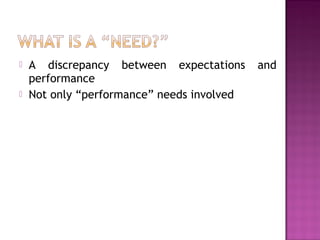Assessment of HRD Needs
- 2. Figuring out what is really needed Not always an easy task Needs lots of input Takes a lot of work “Do it now or do lots more later” First step in HRD process
- 4. A discrepancy between expectations and performance Not only “performance” needs involved
- 5. Performance Diagnostic Factors that can prevent problems from occurring Analytic Identify new or better ways to do things Compliance Mandated by law or regulation
- 6. Focusing only on individual performance deficiencies Doesn’t fix group of systemic problems Starting with a “Training Needs Assessment” If you know training is needed, why waste everyone’s time?
- 7. Using Questionnaires Hard to control input, often high developmental costs, hard to write properly Using soft data (opinions) only Need performance and consequence data Using hard data only Easily measured data is provided, but critical, hard-to-measure data is missing
- 8. Organization Where is training needed and under what conditions? Task What must be done to perform the job effectively? Person Who should be trained and how?
- 9. A broad, “systems” view is needed Need to identify: Organizational goals Organizational resources Organizational climate Environmental constraints
- 10. Ties HRD programs to corporate or organizational goals Strengthens the link between profit and HRD actions Strengthens corporate support for HRD Makes HRD more of a revenue generator Not a profit waster
- 11. Mission statement HRM inventory Skills inventory Quality of Working Life indicators Efficiency indexes System changes Exit interviews
- 12. The collection of data about a specific job or group of jobs What employee needs to know to perform a job or jobs
- 13. Job descriptions Task analysis Performance standards Perform job Observe job Ask questions Analysis of problems
- 14. Develop job description Identify job tasks What should be done What is actually done Describe KSAOs needed Identify potential training areas Prioritize potential training areas
- 15. 1. List tasks 1. Observe behavior List four characteristics of behavior Classify behavior 2. Select verb Knowledge of action verbs Grammatical skills 3. Record behavior State so understood by others Record neatly 2. List subtasks 1. Observe behavior List all remaining acts Classify behavior 2. Select verb State correctly Grammatical skills 3. Record behavior Neat and understood by others 3. List knowledge 1. State what must be known Classify all information 2. Determine complexity of skill Determine if a skill represents a series of acts that must be learned in a sequence Job title: HRD Professional Specific duty: Task Analysis Tasks Subtasks Knowledge and Skills Required SOURCE: From G. E. Mills, R. W. Pace, & B. D. Peterson (1988). Analysis in human resource training and organizational development (p. 57). Reading, MA: Addison-Wesley. Reprinted by permission.
- 16. Determines training needs for specific individuals Based on many sources of data Summary Analysis Determine overall success of the individual Diagnostic Analysis Discover reasons for performance
- 17. Relied on heavily in person analysis Hard to do Vital to company and individual Should be VERY confidential Based too often on personal opinion
- 19. Determine basis for appraisal Job description, MBO objectives, job standards, etc. Conduct the appraisal Determine discrepancies between the standard and performance Identify source(s) of discrepancies Select ways to resolve discrepancies
- 20. There are never enough resources available Must prioritize efforts Need full organizational involvement in this process Involve an HRD Advisory Committee.
- 21. HRD cannot become a slow-acting bureaucracy!! HRD must respond to corporate needs HRD should be focused on “performance improvement,” and not just “training”





















